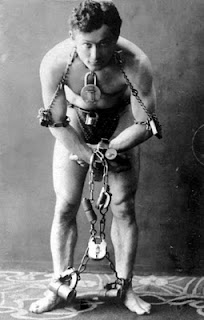
Harry Houdini died in 1926. Yet he is still remembered as the greatest escape artist of all time. Even David Copperfield doesn’t come close in terms of brand and name recognition. That is the power of personal branding. Build a solid personal brand and it catapults you to success. Build a really good personal brand and it survives your death. Will your brand survive 80years or more after your death? More importantly, will your personal brand help you while you are alive?
Just imagine how difficult it was to build a personal brand at the beginning of the 1900’s. There was no Internet. Houdini didn’t have a webpage or videos on YouTube. And he didn’t have the money to buy expensive newspaper or radio advertisements. So how did Harry Houdini create and publicize his personal brand? What can you learn from his rags-to-riches story?
Be the First
Houdini created a new niche – the escape artist. When you are first in your niche you are the standard. He started with card tricks but there were already lots of magicians. So Eric Weiss (real name) created a new type of entertainer – the escape artist.
Be Bold
Houdini was bold. He issued challenges to prisons around the world challenging them to try to restrain him. He then visited the prisons that accepted his challenge and escaped from them. He was a showman. He dangled upside down from a crane over New York City while escaping from a strait jacket and chains. He looked for unique ways to be the news.
Be Provocative
Houdini was provocative. The publicity photo of him that was most often used shows his muscular body almost nude - draped in chains and locks. That photograph must have attracted women and interested men.
Be Creative
Be Bold
Houdini was bold. He issued challenges to prisons around the world challenging them to try to restrain him. He then visited the prisons that accepted his challenge and escaped from them. He was a showman. He dangled upside down from a crane over New York City while escaping from a strait jacket and chains. He looked for unique ways to be the news.
Be Provocative
Houdini was provocative. The publicity photo of him that was most often used shows his muscular body almost nude - draped in chains and locks. That photograph must have attracted women and interested men.
Be Creative
Houdini was creative. He started as a magician but differentiated himself as an escape artist. He invented new stunts and escapes. He made enemies. He challenged spiritualists that claimed they spoke to the dead.
Die Mysteriously
You can’t plan this one but it does contribute to the brand - but not always. Harry Houdini died under mysterious circumstances. He was an extremely fit man who died after a punch to the stomach. He had issued a challenge that he could take any punch to his stomach. Something went wrong and he died after an over-eager challenger punched him.
This method also worked to promote the personal brands of Elvis Presley and Bruce Lee. This is an effective way of enhancing the brand. But you don’t need to do this to build your brand.
Die Mysteriously
You can’t plan this one but it does contribute to the brand - but not always. Harry Houdini died under mysterious circumstances. He was an extremely fit man who died after a punch to the stomach. He had issued a challenge that he could take any punch to his stomach. Something went wrong and he died after an over-eager challenger punched him.
This method also worked to promote the personal brands of Elvis Presley and Bruce Lee. This is an effective way of enhancing the brand. But you don’t need to do this to build your brand.
Harry Houdini did all this and he died in 1926 – long before anyone thought about the concept of personal branding. If you asked Houdini about branding he probably wouldn’t have understood your question. But Houdini sure knew how to build his personal brand. What’s important for you to know is that Houdini did not strive to build a brand. He worked to generate paying customers. All the publicity stunts he did were for the purpose of getting paying customers. Branding was a byproduct.
What can you learn from Harry Houdini, the world’s greatest escape artist, about creating and sustaining your own personal brand?
What can you learn from Harry Houdini, the world’s greatest escape artist, about creating and sustaining your own personal brand?
Don’t focus on building a brand. Instead develop relationships and get more customers. If you build a brand along the way – that’s a nice byproduct.
© George Torok is the coauthor of the bestselling “Secrets of Power Marketing: Promote Brand You” the first guide to personal marketing for the non-marketer. Get your free copy of “50 Power Marketing Ideas” at http://www.PowerMarketing Arrange for Torok to speak to your conference or business meeting at http://www.Torok.com For media interviews call 905-335-1997